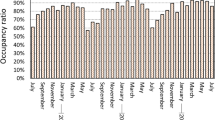Abstract
We consider two CT-scanners in a radiology department of a hospital providing medical service to three patient groups with different arrival patterns and cost-structures: scheduled outpatients, non-scheduled inpatients, and emergency patients. Scheduled outpatients arrive based on an appointment schedule with some randomness due to no-shows. Inpatients and emergency patients arrive at random. The problem is to allocate the available resources dynamically to the patients of the groups such that the expected total reward consisting of revenues, waiting costs, and penalty costs is maximized. We model the problem as as Markov Decision Process and compare it with three decision rules which can be applied in hospitals.
Similar content being viewed by others
References
Barz C and Waldmann K-H (2007). Risk-sensitive capacity control in revenue management. Math Methods Oper Res 65(3): 565–579
Cayirli T and Veral E (2003). Outpatient scheduling in health care: a review of literature. Product Operat Manage 12(4): 519–549
Green LV, Savin SV and Wang B (2006). Managing patient service in a diagnostic medical facility. Oper Res 54(1): 11–26
Klassen KJ and Rohleder TR (1996). Scheduling outpatient appointments in a dynamic environment. J Oper Manage 14(2): 83–101
Lev B, Revesz G, Shea F and Caltagirone R (1976). Patient flow analysis and the delivery of radiology service. Socio-Econ Plann Sci 10: 159–166
Mondschein SV and Weintraub GY (2003). Appointment policies in service operations: A critical analysis of the economic framework. Product Oper Manage 12(2): 266–286
Patrick J, Puterman ML, Queyranne M (2006) Dynamic multi–priority patient scheduling for a diagnostic resource. Technical report, Sauder School of Business, University of British Columbia
Patrick J and Puterman ML (2007). Improving resource utilization for diagnostic services through flexible inpatient scheduling: a method for improving resource utilization. J Oper Res Soc 58: 235–245
Puterman ML (2005). Markov decision processes: discrete stochastic dynamic programming. Wiley, New York
van Dijk N, van der Sluis E, Haijema R, Al-Ibrahim A, van der Wal J (2005) Simulation and or (operations research) in combination for practical optimization. In: Proceedings of the 2005 winter simulation conference, 2005
Walter SD (1973). A comparison of appointment schedules in a hospital radiology department. Br J Preventive Soc Med 27: 160–167
Author information
Authors and Affiliations
Corresponding author
Rights and permissions
About this article
Cite this article
Kolisch, R., Sickinger, S. Providing radiology health care services to stochastic demand of different customer classes. OR Spectrum 30, 375–395 (2008). https://doi.org/10.1007/s00291-007-0116-1
Published:
Issue Date:
DOI: https://doi.org/10.1007/s00291-007-0116-1




